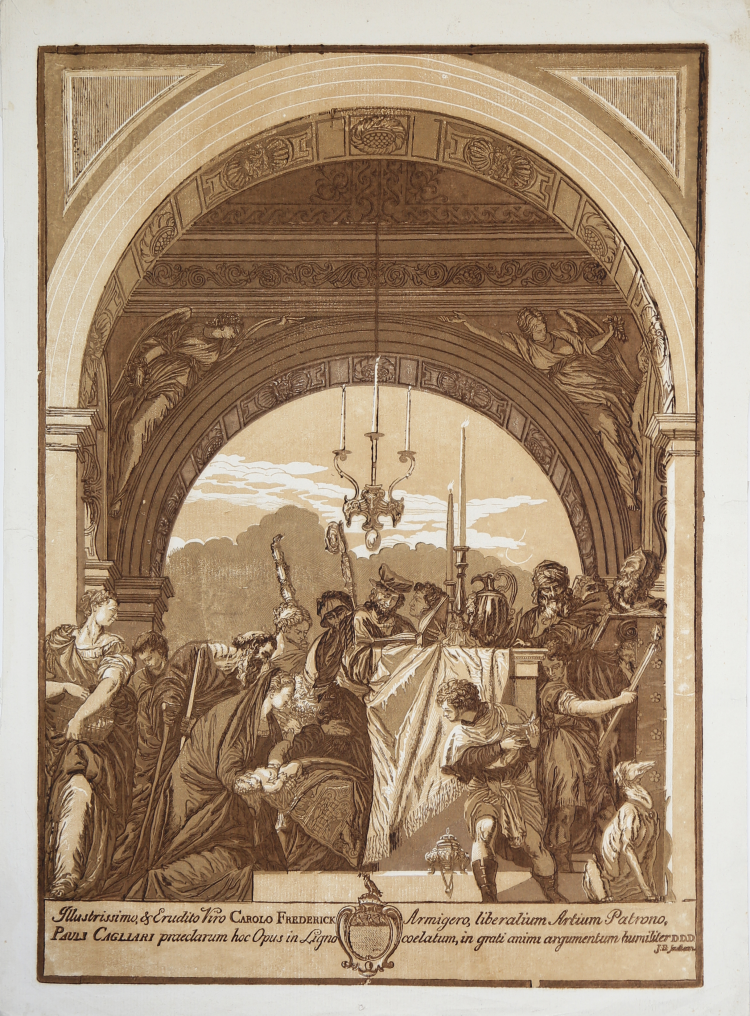



| Reference: | S17232 |
| Author | John Baptiste JACKSON |
| Year: | 1745 |
| Measures: | 382 x 537 mm |


| Reference: | S17232 |
| Author | John Baptiste JACKSON |
| Year: | 1745 |
| Measures: | 382 x 537 mm |
Chiaroscuro woodcut, 1745. inscribed lower center: “Illustrissimo, & Erudito Viro CAROLO FREDERICK Armigero, liberalium Artium Patrono, / Pauli Cagliari praeclarum hoc Opus in Ligno coelatum, in grati animi argumentum humiliter D. D. D. / J: B: Jackson”. After Paolo Veronese.
Good example, printed on contemporary laid paper, white margins, in very good condition.
Published as 1 of 24 prints and originally issued in portfolio with title: “Titiani Vecelli, Pauli Caliarii, JacobiRobusti, et Jacobi de Ponte opera selectiora”
The plate is after an organ shutter of ca. 1588 painted by Paolo Veronese (1528-1588) for the Church of San Sebastiano, Venice. In 1558, Paolo designed the organ and painted its external shutters with the Presentation of Christ and the internal ones with a Pool of Bethesda (1560). The Presentation represents the bringing of the infant Jesus by Mary and Joseph to the Temple in Jerusalem to be 'consecrated to the Lord.' The Jewish rite of the 'purification' of the mother was celebrated simultaneously and involved the sacrifice of doves or pigeons and incorporated a procession of candles, both of which are portrayed by Veronese. The painted and actual architecture of Paolo's organ in San Sebastiano are coordinated so that, whether the shutters are open or closed, painted architecture continues the organ’s exterior architecture in both perspective and vocabulary.
|
Kainen, Jacob. John Baptist Jackson : 18th-century master of the color woodcut, 1962
|
John Baptiste JACKSON (1701 - 1780)
|
English wood-engraver and wallpaper manufacturer. He trained as a wood-engraver, first in London with Edward Kirkall (1695–1750) and then c. 1726 in Paris under Jean-Michel Papillon. He parted from Papillon on bad terms and went on to Rome first, and then to Venice, specializing in the chiaroscuro technique. His six Heroic Landscapes after gouaches by Marco Ricci were printed in 7–10 colours. He returned to London in 1746 and founded a wallpaper manufacturing company in Battersea. There he applied the chiaroscuro technique to produce wallpaper panels printed with oil-based colours, imitating the appearance of the print rooms of the day with their framed engravings and landscapes in roundels surrounded by Baroque frames. He also engraved imitation stucco arrangements of ornamental foliage in the Italian style, as well as statues and trophies. He published a vigorous defence of his claims for recognition as an inventor of the technique of printing and engraving in chiaroscuro in a treatise of 1754. The sweeping scale of his work gave new life to the art of wallpaper manufacture, and the Italian influences that he succeeded in assimilating into an original and expressive style contrasted sharply with the then predominating vogue for Chinese papers. Various documents and an album attributed to Jackson’s workshop are preserved in the Victoria and Albert Museum, London.
|
|
Kainen, Jacob. John Baptist Jackson : 18th-century master of the color woodcut, 1962
|
John Baptiste JACKSON (1701 - 1780)
|
English wood-engraver and wallpaper manufacturer. He trained as a wood-engraver, first in London with Edward Kirkall (1695–1750) and then c. 1726 in Paris under Jean-Michel Papillon. He parted from Papillon on bad terms and went on to Rome first, and then to Venice, specializing in the chiaroscuro technique. His six Heroic Landscapes after gouaches by Marco Ricci were printed in 7–10 colours. He returned to London in 1746 and founded a wallpaper manufacturing company in Battersea. There he applied the chiaroscuro technique to produce wallpaper panels printed with oil-based colours, imitating the appearance of the print rooms of the day with their framed engravings and landscapes in roundels surrounded by Baroque frames. He also engraved imitation stucco arrangements of ornamental foliage in the Italian style, as well as statues and trophies. He published a vigorous defence of his claims for recognition as an inventor of the technique of printing and engraving in chiaroscuro in a treatise of 1754. The sweeping scale of his work gave new life to the art of wallpaper manufacture, and the Italian influences that he succeeded in assimilating into an original and expressive style contrasted sharply with the then predominating vogue for Chinese papers. Various documents and an album attributed to Jackson’s workshop are preserved in the Victoria and Albert Museum, London.
|